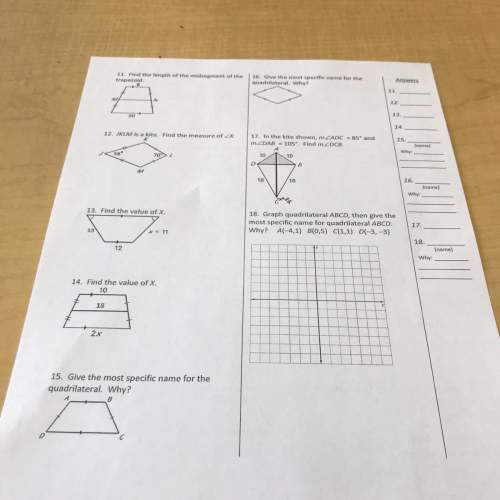
Mathematics, 04.12.2019 03:31 cloey6544
This is an exercise around linearization of a scalar system. the scalar nonlinear differential equation we have is r(t)= sin(x(t)) + u(t). (a) the first thing we want to do is find equilibria (dc operating points) that this system can support. suppose we want to investigate potential expansion points (x",u") with u. = 0. sketch sin(x*) for 4π x< 4π and intersect it with the horizontal line at 0 this will show us the equilibria points. where sin(x0. (b) show that all r(r) = satisfy (7) together with u" = 0. let us zoom in on two choices: π and representative points.) = o. (looking at the sketch we made, these seem like (c) linearize the systern (7) around the equilibrium (x0,u") = (0,0). what is the resulting linearized scalar differential equation for (t)-x-x(t)-0, involving udr) = u(r) _ u" = u(t) 0? (d) for the linearized approximate system model that you found in the previous part, what happens if we try to discretize time to intervals of duration δ? assume now we use a piecewise constant control input over duration δ, that δ is small relative to the ranges of controls applied, and that we sample the state x every δ (that is, at every 1 na where n is an integer) as well write out the resulting scalar discrete-time control system model. this model is an approximation of what will happen if we actually applied a piecewise constant control input to the original nonlinear differential equation. (e) is the (approximate) discrete-time system you found in the previous part stable or unstable? (f) now linearize the system (7) around the equilibrium (x, u") ( π.0), what is the resulting approximate scalar differential equation ) 0? (g) for the linearized system model that you found in the previous part, what happens if we try to discretize time to intervals of duration δ? assume now we use a piecewise constant control input over duration that δ is small relative to the ranges of controls applied, and that we sample the state x every δ (that is, at every , = na, where n is an integer) as well, write out the resulting scalar discrete-time control system. this model is an approximation of what will happen if we actually applied a piecewise constant control input to the original nonlinear differential equation. (h) is the (approximate) discrete-time system you found in the previous part stable or unstable? (i) suppose for the two discrete-time systems above, we chose to apply a feedback law u(r) =-k(x(1) x"). for what range of k values, would the resulting linearized discrete-time systems be stable? your answer will depend on δ.

Answers: 1
Another question on Mathematics

Mathematics, 21.06.2019 12:30
(01.04 mc) an ice sculpture is melting because of heat. assuming its height changes bynegative 5 over 32m every hour, what will be the change in height after 4 hours?
Answers: 2

Mathematics, 21.06.2019 13:50
James wants to promote his band on the internet. site a offers website hosting for $4.95 per month with a $49.95 startup fee. site b offers website hosting for $9.95 per month with no startup fee. for how many months would james need to keep the website for site a to be a better choice than site b? define a variable for the situation. write an inequality that represents the situation. solve the inequality to find out how many months he needs to keep the website for site a to be less expensive than site b. using words, describe how many months he needs to keep the website for site a to be less expensive than site b.
Answers: 1

Mathematics, 21.06.2019 14:10
Plzzz plzz maths ! quadratic sequences =an^2+bn 1) 1,6,15,28,45 2)5,18,39,68,105 3) 1,8,21,40,65 4) 7,24,51,88,135 5) -1,2,9,20,35
Answers: 3

Mathematics, 21.06.2019 14:40
The physical fitness of an athlete is often measured by how much oxygen the athlete takes in (which is recorded in milliliters per kilogram, ml/kg). the mean maximum oxygen uptake for elite athletes has been found to be 60 with a standard deviation of 7.2. assume that the distribution is approximately normal.
Answers: 3
You know the right answer?
This is an exercise around linearization of a scalar system. the scalar nonlinear differential equat...
Questions

Chemistry, 28.10.2019 23:31

Mathematics, 28.10.2019 23:31


Mathematics, 28.10.2019 23:31

History, 28.10.2019 23:31

Physics, 28.10.2019 23:31


Biology, 28.10.2019 23:31





English, 28.10.2019 23:31










